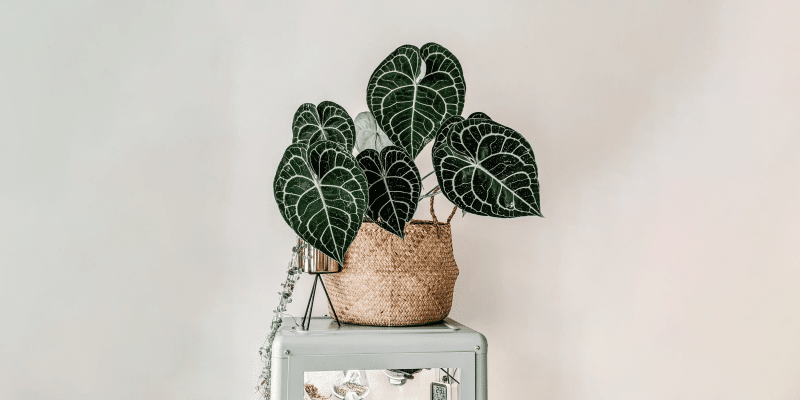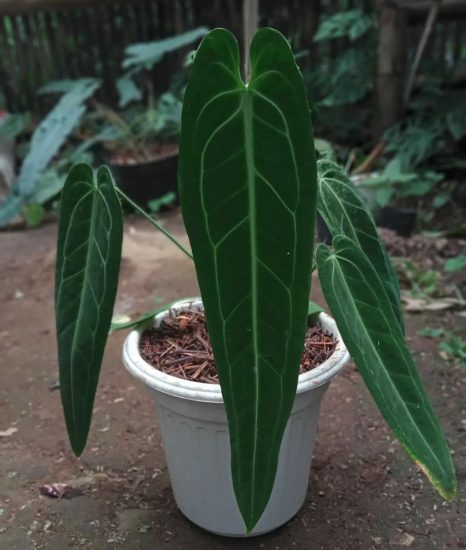You find yourself strolling through the jungle, the air heavy with humidity, the sounds of parrots squawking overhead. Around you are vibrant, rich greens and large, broad leaves.
Was it a dream? Maybe the parrots. But the rest? We could simply call it: Anthurium.
These evergreen beauties, commonly known as “flamingo flowers,” are about as close to a tropical vacation as you can get without breaking out your passport. From their waxy, heart-shaped leaves to their show-stopping blooms, anthuriums have a certain je ne sais quoi that can make even the dreariest of spaces feel like a lush, botanical garden.
But you don’t need to be a horticultural wizard to keep these stunning plants alive and thriving.
We’ll introduce you to the fabulous world of anthurium houseplants, showcasing their unique features, and sharing tips and tricks for keeping them happy and healthy.
By the end of this article, you’ll have all the knowledge you need to grow anthurium and transform your space into a tropical paradise.
Table of Contents
Anthurium Plant Care Guide
History, habitat, and characteristics
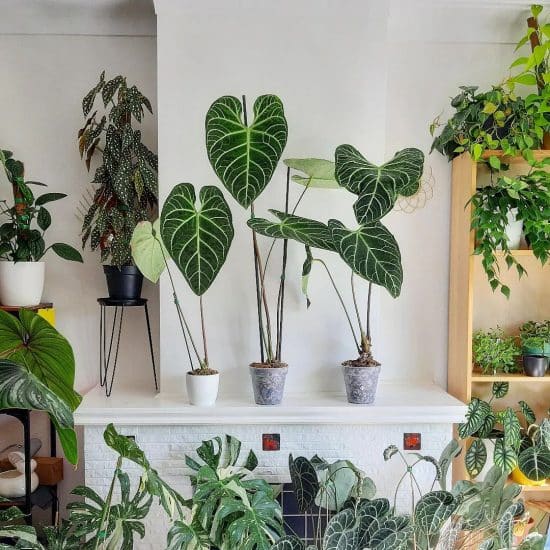
Anthurium, often nicknamed “flamingo flowers” or “tail flowers,” feature a striking appearance and have a bit of a ‘bad boy’ reputation for having difficult needs. But . . . those leaves. With their striking appearance, it’s no wonder they’re a favorite among both plant enthusiasts and renowned artists.
These tropical beauties, hailing from South America, are part of the largest aroid genus, boasting approximately 1,000 known species. With their broad leaves and captivating flowers, anthurium can be found in a variety of habitats, from high-altitude rainforests in the Andes, where they live among the cloud forests, to the cozy corners of your living room.
We’ll cover how to grow anthurium plants in a moment, but first, let’s get into a few of our favorite varieties.
Varieties
With around so many unique species, the Anthurium genus has something for everyone. While we can’t cover every single variety here, we’ll introduce you to some popular and eye-catching favorites:
Anthurium andraeanum: Large, heart-shaped leaves in deep green alongside magnificent bright red, pink, or white spathes. The vibrant colors of this variety make it a recognizable “flamingo flower.”
Anthurium crystallinum: Velvety, bold leaves that feature striking white veins, giving the plant a crystal-like appearance. Ideal for adding a touch of elegance and sophistication to your space.
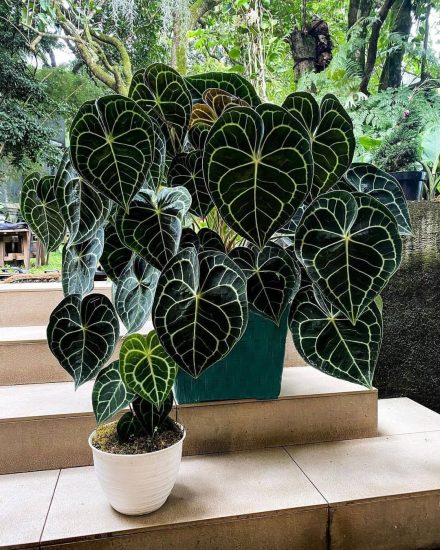
Anthurium clarinervium: With its distinctive dark green and heart-shaped leaves adorned with contrasting white veins, this beauty makes a remarkable visual statement. It can be easily recognized and appreciated for its charming foliage.
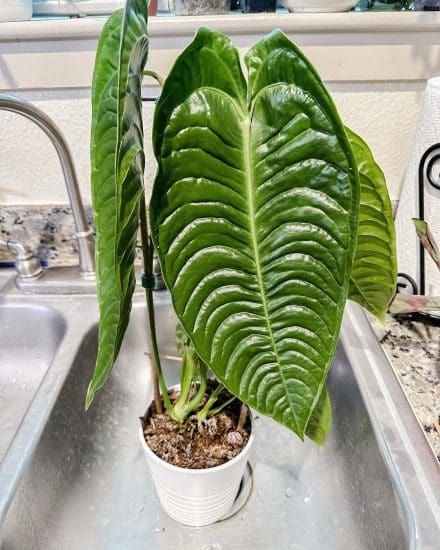
Anthurium veitchii: Its leaves change from broad, heart-shaped structures in their early stages to elongated, spear-like leaves with prominent midribs and veins, creating a corrugated texture. The spacing and maturity of the leaf corrugation in the narrow and wide forms differs.
Queen Anthurium: A royal addition to your collection, Queen Anthurium features large, dark green leaves with stunning silvery-white veins that catch the eye. The velvety leaves can grow up to an impressive 6 feet in length under optimal conditions. The flowers, although small and hidden by the foliage, add an extra element of intrigue.
Anthurium superbum: A truly unique species, this variety is characterized by long, ruffled leaves that fan out from the center, resembling a bird’s nest. This distinctive look makes it a bold and fascinating addition to your collection.
Anthurium scherzerianum: Fondly referred to as the “pigtail anthurium,” this delightful plant features curled spadices and brightly colored spathes in shades of red, orange, or pink. The combination of the distinctive spadices and vivid spathes make this variety a standout among other Anthuriums.
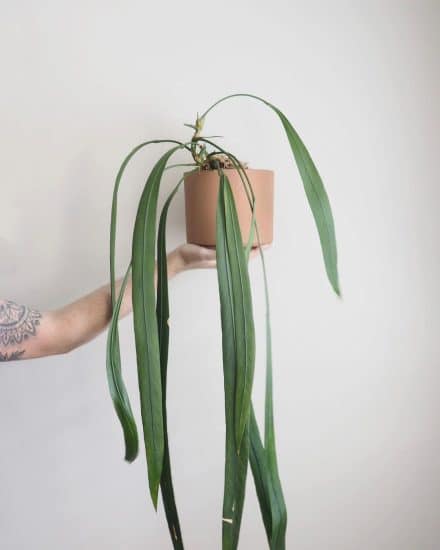
Anthurium vittariifolium: Often called the “strap-leaf anthurium,” this Anthurium is known for its long, slender leaves that elegantly drape downward, creating an air of grace and sophistication. The leaves can reach lengths of up to 4 feet and boast a deep green hue with an alluring, glossy sheen.
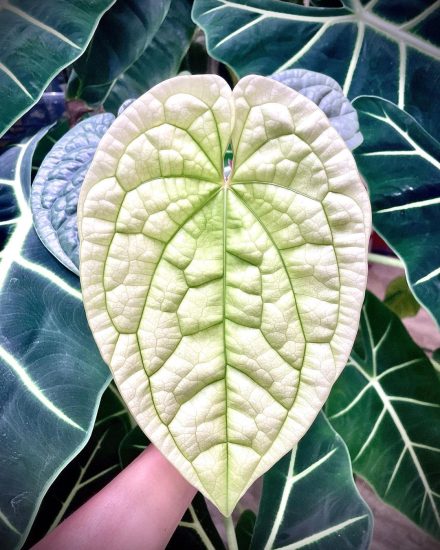
Anthuriums have some truly intriguing and distinctive features that set them apart in the plant world. Let’s explore a few key characteristics:
Spadix and spathe: The spadix is a spike-shaped structure that houses the tiny flowers, while the spathe is the colorful modified leaf that surrounds the spadix. Together, they create the iconic “flamingo flower” appearance.
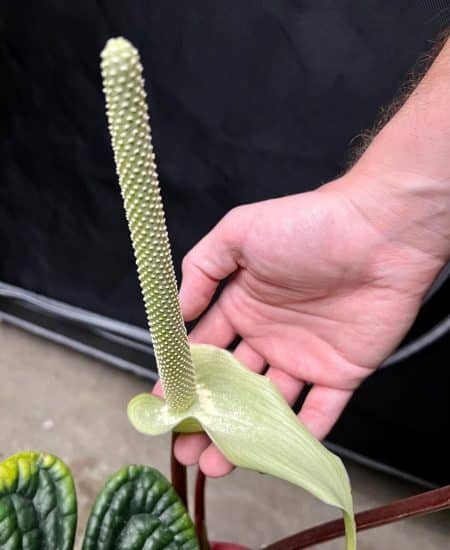
Guiniculum: connects the leaf to the spadix and allows the leaf to move about, catching sunlight like a pro.
Variety of leaf textures and colors: Anthuriums boast an array of leaf colors and textures, which also serve as a handy clue to their preferred light conditions and water requirements.
Light
We’re going to start our anthurium care journey with a straightforward subject: light.
First things first, anthuriums do best in bright, indirect light.
Keep them away from direct sun, which can hurt their arrow-shaped leaves and stunt any flower growth. As different anthuriums require slightly different conditions, you’ll want to pay attention to the color of the leaves for a hint about their ideal light conditions.
Brighter green or silver shades need more light, while darker shades are happier in more shaded environments. Typically, the more chlorophyll we see in a leaf, the less light it’s going to need.
If your anthurium isn’t getting enough light, you might see signs like slow growth, fewer flowers, smaller leaves, or less vibrant colors. On the other hand, too much direct light can lead to scorched leaves, faded colors, or even sunburn on the leaves and flowers.
Water
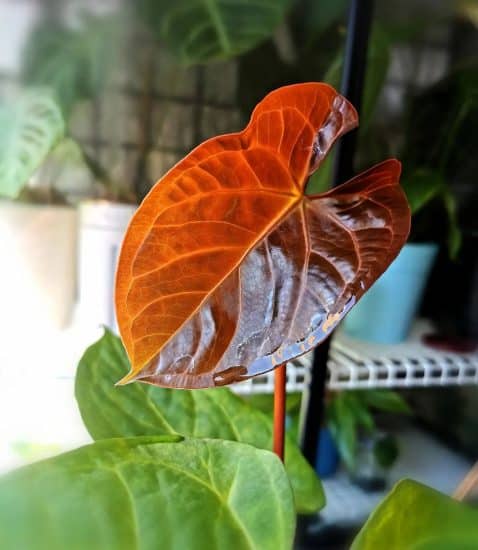
Getting the water requirements just right for your indoor anthurium plants is key to keeping them healthy and vibrant. Let’s dive into the signs of overwatering and underwatering, and how to find the perfect balance for these indoor plants.
Anthurium like their soil moist, but not waterlogged. Out in the wild, they can be watered daily, but indoors, you should water until you notice water draining through the bottom of your pot, using room temperature water.
The frequency of watering depends on the specific variety, but generally, you shouldn’t let anthurium plants dry out completely between watering.
When your anthurium isn’t getting enough water, you’ll notice wilting leaves and stunted growth. Keep an eye out for the oldest leaves (those at the bottom) turning yellow, which means your plant is craving more frequent watering. If those leaves also feel dry and brittle, it’s a telltale sign that you’re underwatering.
Too much water can lead to problems, causing leaves to turn yellow and feel soft. Your plant might even give off a bit of a smell. To avoid overwatering, ensure the top inch or two of the well-draining soil is dry before giving your anthurium another drink.
Our tips:
- Feel the top inch or two of soil before watering to make sure it’s almost dry.
- Stick to room temperature water, since cold water can shock your plant.
- Pay attention to your anthurium’s leaves – if they’re crispy or wilting, it needs more water; but if they’re soft and yellow, it might be overwatered.
Temperature and humidity
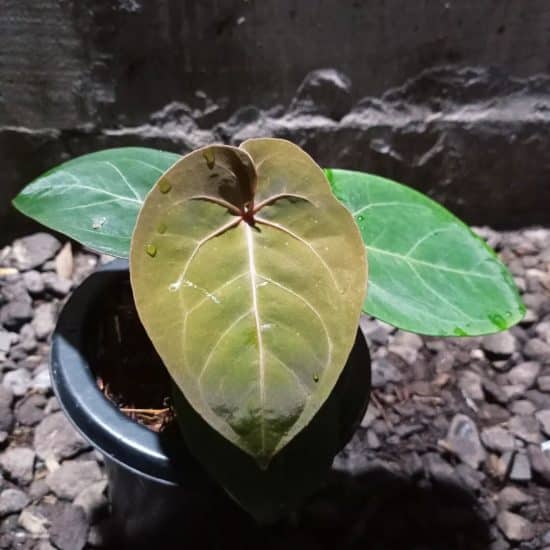
Anthurium prefer warm temperatures between 65 and 80 degrees Fahrenheit (18 to 20 degrees Celsius). They are sensitive to extreme temperatures and should not be exposed to anything below 55 degrees or above 90 degrees F.
Keep your anthurium in a warm spot away from drafty windows, doors, and air conditioning vents to avoid sudden temperature fluctuations. If you notice your anthurium’s leaves turning yellow or wilting, it could be a sign of temperature stress.
While high humidity isn’t a strict requirement for all anthuriums, maintaining good air circulation and humidity is crucial for their health. Grouping other plants together can help increase humidity levels, but make sure there’s enough space between them for proper air circulation.
Using a fan in the room can also help with air circulation, but avoid placing it directly on the anthurium to prevent leaf damage.
Tips:
- Position your anthurium in a spot with warm temperatures between 65-80°F and avoid drafty windows or air conditioning vents.
- To increase humidity, group plants together, but ensure they have enough space for proper air circulation.
- If you’re still struggling with humidity levels, consider placing a pebble tray (water, pebbles, evaporation magic!) beneath your anthurium, or use a humidifier nearby.
Soil and Planting
The ideal soil composition for your anthurium is a well-draining mix using a combination of potting soil, orchid bark, and perlite.
Signs of poor soil and issues with the wrong potting soil can include yellowing leaves, wilting, and a lack of new growth. If you notice any of these symptoms, it might be time to revisit your soil composition and make adjustments. Remember that a well-draining mix is crucial for anthurium, as they are susceptible to rot if left sitting in overly wet soil.
Anthurium plants prefer a phosphorus-rich fertilizer. Using a fertilizer high in phosphorus will promote blooms. Just make sure to start slow with a diluted liquid base.
Signs of too much fertilizer can include leaf burn, a salty buildup on the soil surface, and stunted or weak growth. If you suspect over-fertilization, water your soil thoroughly to leach out excess nutrients. Keep a close eye on your plant and adjust your fertilization routine accordingly.
Remember: start slow!
When pruning your anthurium, ensure you leave at least four leaves on the plant. If you see aerial roots growing out of your pot, this is totally normal and expected with a healthy plant. There’s no need to repot or trim.
Propagation guide
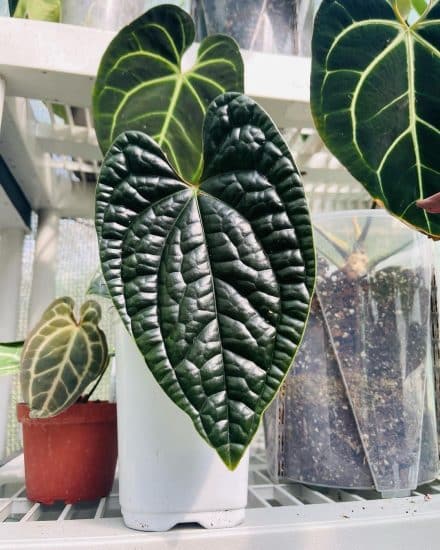
So you’re head over heels for your lovely flamingo flower and its exotic, vibrant blooms? Great news! We’ve got a super easy stem-cutting method that’ll help you propagate more of these beauties.
Propagating anthurium plants with stem cuttings:
- You’ll want to choose a healthy stem from your anthurium mama plant. Look for a stem that has at least 2-3 lively leaves. Grab your sterilized shears and snip that stem right below a node, leaving about 4-6 inches of stem length.
- Before you dip your fresh cutting into some water, make sure to let it callus overnight. This crucial step allows the cutting to dry out a little and helps it fight off any rot when it takes the plunge into water.
- Find a cute little container like a glass or jar that’s perfect for your anthurium cutting. Fill it up with some filtered or bottled water at room temperature. Rainwater works wonders too if you’ve got some stashed.
- Submerge the bottom few inches of the stem, with the callused end, into the water. Don’t forget to strip off any leaves that might touch the water. Give your cutting a cozy spot with bright, indirect light to chill in.
- Remember to change the water every 2-3 days and watch for those adorable baby roots to sprout in a few weeks. When your little anthurium’s roots hit the 2-inch mark, you’re ready to transplant.
- Pick a well-draining potting mix, and find a nice home (aka container) for your young anthurium. Carefully nestle the rooted cutting in the soil, watching out for those delicate new roots. Water your newly potted anthurium thoroughly, and keep up the care with regular watering and high humidity.
Feeling the propagation itch during winter? No worries! Just make sure the light and humidity levels stay high. However, spring and summer propagation gives you a better shot at success.
If you catch any leaves turning yellow or wilting during propagation, gently remove them to help your plant focus its energy on helping those anthurium roots grow.
Common Issues
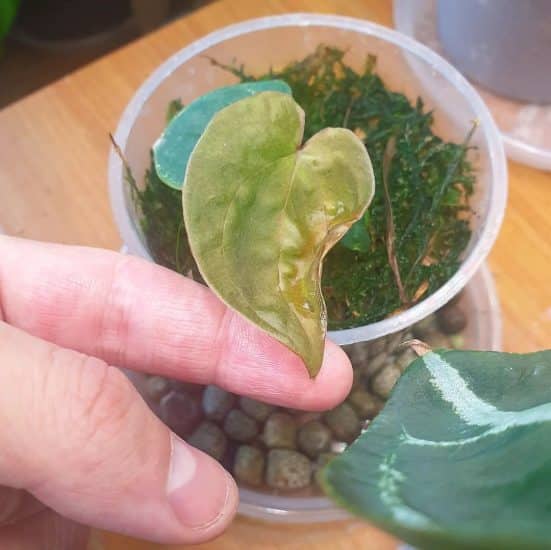
We’ll focus on two common issues that many indoor plants like Anthurium face: brown leaf tips and yellow leaves.
Brown Leaf Tips
This can often be a sign of low humidity or improper watering. To help your plant out, try increasing the humidity around it by using a humidifier or simply placing a tray of water nearby. You can even give it a gentle mist now and then. Also, ensure you’re watering consistently – the top layer of potting soil should dry out a bit between waterings.
Now, if those brown tips still stick around, over-fertilization might be the culprit. To avoid that, follow the recommended fertilization schedule on the bottle and hold back on using too much fertilizer. If you think over-fertilization is the issue, flush the soil with water, wait a few weeks, and see how your plant responds before applying any new fertilizer at half-strength.
Yellow Leaves
Take a closer look at the leaves. Are they yellow and soft? If so, you might be overwatering your plant. To solve this, let the soil dry out before watering again and make sure your pot has a drainage hole.
Now, if the leaves are yellow and crispy, it’s likely under-watering. Make sure you’re watering consistently, but remember, the top layer of potting soil should be a little dry in between waterings.
And lastly, if your anthurium is getting too much direct sunlight or intense light, you’ll see yellow leaves from sunburn. In that case, find a spot with bright, indirect sunlight for your indoor plants to keep them happy.
Pests and diseases
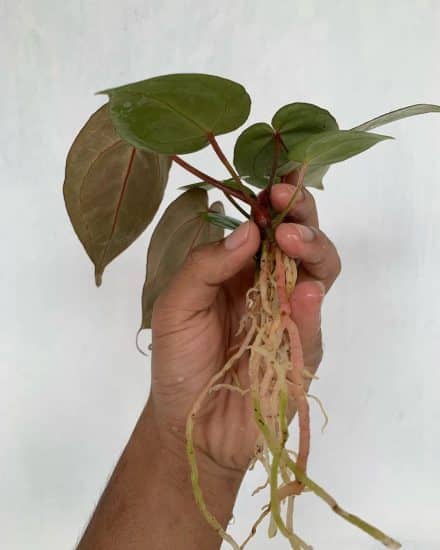
Anthurium plants can suffer from both of these issues, but they’re a bit unique. Since they prefer a higher level of humidity than most indoor plants, it’s unlikely you’ll see spider mites, but fungal issues can be quite common without sufficient airflow.
Root Rot
It’s a common issue for Anthurium, and it creeps in when the roots get waterlogged from overwatering or poor drainage. Look out for yellowing or wilting leaves and any black, slimy roots – those are telltale signs of root rot.
To treat root rot, carefully remove the plant from its pot, trim away droopy leaves, and snip off those icky, affected roots. Sterilize your pruning shears with rubbing alcohol or boiling water, both before and after use.
Repot your anthurium in fresh, well-draining soil (goodbye, soggy roots!), and ensure the pot has a few drainage holes. Moving forward, let the soil dry out before watering.
Fungus Gnats
Little flying insects called fungus gnats can sometimes infest an anthurium plant. These tiny troublemakers love damp soil and like to hang out around the base of the plant or under the foliage. Look for minuscule black or gray flies buzzing around, or their white, thread-like larvae wriggling in the soil.
A great way to keep fungus gnats at bay is by using a potting soil alternative like a mix of perlite, coco coir, and bark. This less inviting environment isn’t the best place for gnats to lay their eggs.
If you’re already dealing with an infestation, let the top inch of soil dry out (sayonara, larvae!) and use a mix of water and insecticidal soap or neem oil on the affected areas.
Conclusion
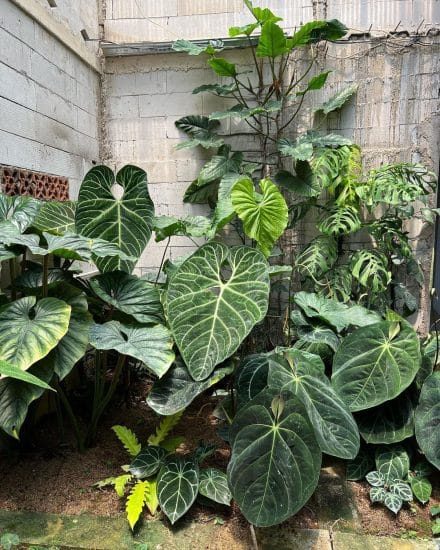
That’s a wrap on how to grow Anthurium! Unlike some other houseplants, most plants in the genus really do love high levels of humidity and can be a bit trickier to propagate. We’ll leave you now with a few tips to keep in mind.
Anthurium care summary:
- Keep your anthurium away from direct sunlight, as this can cause leaf scorching and faded colors. Anthurium prefer bright indirect light, especially in the growing season. Low light usually means slow growth and an unhealthy plant.
- Monitor your plant’s water needs closely, ensuring the top inch or two of soil is almost dry between waterings.
- Anthurium absolutely need high humidity to grow well, and prefers a bit of air circulation as well to keep pests and rot away.
- Your potting mix should be well-draining (you can add perlite and bark to regular potting soil). Add a fertilizer high in phosphorus for more blooms and faster growth.
We hope this guide has been helpful! If you have any questions or need further assistance, don’t hesitate to reach out to us. And if you found this guide useful, feel free to share it with fellow plant enthusiasts!
Take care, and happy growing!
FAQ
Do anthurium make good indoor plants?
Absolutely! Anthurium are known for being adaptable and can brighten up your indoor space with their tropical charm, especially their pink tail flowers.
Thanks to their natural habitat, they thrive in lower light conditions, making them a great addition to your indoor jungle.
Are anthurium plants poisonous to touch? Are they toxic?
While anthurium are seriously enchanting, it’s essential to note they do contain calcium oxalate crystals, which can be toxic to people and pets if ingested. However, simply touching the plant yourself will be generally safe.
Why are anthurium called flamingo flower or tail flower?
Anthurium plants boast a unique structure, with a large, waxy, heart-shaped bract known as the spathe that showcases a vivid color palette. These colors may vary from bright red to pink, white, or even purple, closely resembling the lovely hue of a flamingo. Plus, the curvy shape of the spathe is reminiscent of a flamingo’s long neck, gracefully bending and turning.
As for the “tail flower moniker,” anthuriums have a distinctive central part called the spadix. This elongated, cylindrical structure seems to emerge straight from the heart of the spathe, resembling a tail.

